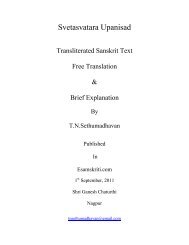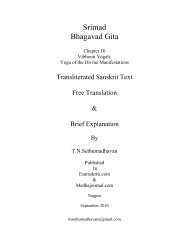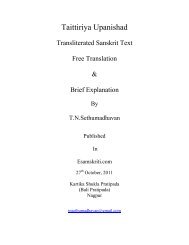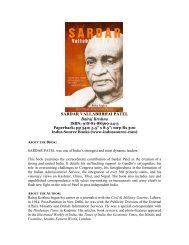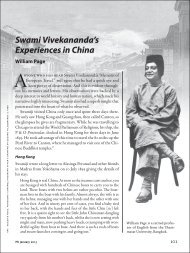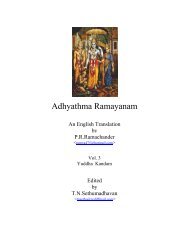SRIMAD BHAGAVAD GITA - Esamskriti.com
SRIMAD BHAGAVAD GITA - Esamskriti.com
SRIMAD BHAGAVAD GITA - Esamskriti.com
- No tags were found...
You also want an ePaper? Increase the reach of your titles
YUMPU automatically turns print PDFs into web optimized ePapers that Google loves.
turning away from war and overwhelmed with grief he sinks into the chariot layingdown his arms. Thus we see that it is delusion which changes a hero’s great courageinto anxiety and worry state neurosis.Dr.S.Radhakrishnan says that Arjuna’s cry or demand was simple yet tremendous anddamaging one, “significant of the tragedy of man, which all, who can see beyond theactual drama of the hour, can recognize. The mood of despair in which Arjuna isfound in the 1 st Chapter of the Gita is what the mystics call the dark night of the soul,an essential step in the upward path. Krishna stands for the voice of God, deliveringthe message in the thrilling notes, warning Arjuna against dejection of spirit. As thedialogue proceeds, the dramatic element disappears. The echoes of the battlefield dieaway and we have only an interview between God and man”.Live as the Gita teaches you to LiveThe core teaching of Krishna in the Gita is that where there is virtue there is theprospect of victory and glorious life, both in this world and hereafter and whereverthere are vice, unrighteousness, injustice and immorality, there is destruction,physical, moral and spiritual.The senses of ‘I’, ‘Me’, and ‘Mine’ are the root of all evils and bondages in the worldand the senses of ‘you’ and ‘your’ bring freedom to the soul. A wise man is the onewho goes beyond the sense of ‘I’, and knows the secret of ‘you’ by which he gets ridof the senses of ‘I’ and ‘Mine’. As long as we remain selfish we are caught in the netof desires and the world, so long we shall not be able to realize the real essence of theGita. So Krishna says detachment is freedom and attachment is bondage. Therefore heinstructs everybody to perform work disinterestedly without asking for results thereofbecause desire for the result of works is the chain that binds men and drags them intothe den of delusion or maya.Krishna represents the realized soul free of all conditioning, capable of seeing thetruth as it is. He is the Self in a state of sat-chit-ananda. Arjuna is consciousnesscrumpled by conditioning. The chariot he rides is the body. The horses are the senses.The two wheels are the desire and destiny. As a charioteer, Krishna does two things -1. He helps Arjuna to realize the true nature of life and 2. He overpowers the forcesthat threaten social order.He classifies all actions into two viz. reaction and response; the former is guided byone’s ego, motivated by one’s desires and the latter is guided by one’s intellectmotivated by one’s duty. The former focuses on result while the latter focuses onaction. Krishna proves that by responding rather than by reacting, by maintainingequanimity and not getting provoked by worldly stimuli, it is possible to satisfy thedemands of worldliness, fulfill one’s obligation to the society, repay one’s debts toancestors and still attain moksha, liberation.The varnashrama dharma categorizes life into four stages to be lived sequentiallyviz., brahmacharya, grihasta, vanaparstha and sanyasa. Krishna’s suggestion is thatsimultaneous rather than sequential achievement of material joy and spiritual bliss ispossible.



